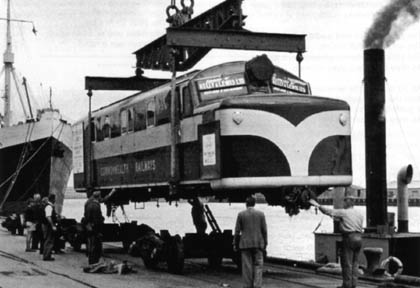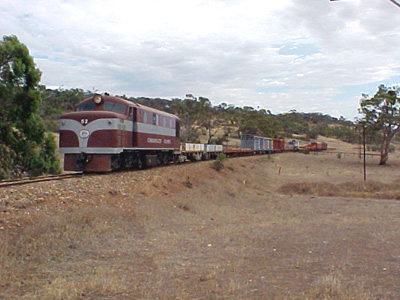When diesel-electric locomotives were sought for the narrow gauge the Commonwealth Railways called for tenders and ultimately selected a Sulzer-powered design proposed by the Birmingham Carriage and Wagon Company, England, as being the most suitable choice for the harsh desert conditions of the Central Australia Railway.
An order for fourteen locomotives was placed and delivery was anticipated in 1952, but for various reasons was delayed until 1954. The first engine, NSU51, was officially placed in service and named George McLeay (the Federal Minister for Shipping) by his wife in a special ceremony at Port Augusta on 12 June 1954. The locomotive had been temporarily placed on standard gauge bogies, and following the ceremony it hauled the guests on a special run to Bookaloo (68 km) and return. In the meantime NSU52 was the first of the class to journey through the Pichi Richi Pass to Quorn. By late 1955 all of the locomotives were in service. An additional advantage of these locomotives was their ability to operate in pairs. Only a single crew was necessary as the second unit could be operated by remote control cables.
.jpg)
Within a few years the 14 members of the class had replaced almost all steam working on the Commonwealth Railways narrow gauge lines. Two were sent to the North Australia Railway, and one was based at Quorn for a time as a shunter and to work the Hawker freight. Their main stamping ground, though, was the Central Australia Railway and they continued to work that line, along with the NT and NJ class diesels that were introduced later, until the winding down of services and eventual closure released them for other duties. Six were last used on railway recovery trains during the demolition of the old Central Australia Railway—the line that they were built to operate. Meanwhile up to two were in use for a time on each of the former SAR narrow gauge lines, Peterborough to Quorn and Gladstone to Wilmington, and to NSUs 53 and 58 fell the honour of running the last freight into Quorn on 14 August 1980.
When additional locomotives were required on the Central Australia Railway another Sulzer-powered design was chosen—the NT class—but they were built in Australia by Tulloch Ltd of Rhodes, NSW. The initial order of three units were delivered on standard gauge bogies to Broken Hill where their narrow gauge bogies were fitted. From there they worked to Quorn via Peterborough, and then ran down through the Pichi Richi Pass to Port Augusta. In 1966 an additional ten locomotives were ordered, and they too were delivered via the Pichi Richi Pass. It was believed that when NT77, the last of the order, travelled through the Pass in September 1968 it constituted the final movement over the line as shortly after the line was severed when the Saltia bridge was damaged.
The final development of motive power on the Central Australia Railway narrow gauge was the NJ class—six GM powered units built by Clyde Engineering, and introduced in 1971. With the cessation of services the NJs were all transferred to the Port Lincoln Division. Two NT's were allotted to each of the Gladstone to Wilmington and Peterborough to Orroroo lines. By 1984 their only duties were the handling of grain traffic.
During 1980 non-operational NSU51, 'George McLeay', was brought through the Pass to be preserved as a static exhibit at Quorn. However, in view of the NSU's links with Quorn many people thought that the preservation of a member of the class in working order was desirable, and an appeal for funds was made to members of the Pichi Richi Railway Preservation Society (PRRPS). This enabled NSU52 to be purchased, and on 24 April 1982 our first operational main line diesel came up through the Pass. Twenty-eight years before NSU52 had been the first diesel electric to arrive at Quorn.
Finally in late 1983 Australian National called public tenders to dispose of its remaining out of service ex Central Australian locomotives and the PRRPS was able to secure NSU54 as a back up for NSU52.
Technical specifications
| Wheel arrangement | A1A-A1A | |
|---|---|---|
| Engine | Sulzer 6LDA 28 | |
| Weight | 62 tons 13 cwt | 63.5 t |
| Length | 41 ft 10 in | 12.75 m |
| Power | 850 hp | 635 kW |
| Max Axle Load | 10.5 tons | 10.7 t |
| Max Speed | 50 mph | 80 km/h |
Representatives in the Pichi Richi Railway collection
NSU51
| Builder | Birmingham Carriage and Wagon Co. |
|---|---|
| Entered service | 3 June 1954 |
| Builder’s number | DEL1 |
| Withdrawn from service | 1980 |
| Distance travelled in service | 1,019,115 miles |
| Acquired by PRRPS | 14 June 1980 |
| Notes | Named George McLeay (Federal Minister for Shipping. Hauled special train on standard gauge for guests, 12 June 1954. In service on the Central Australian Railway 13 June 1954. Hauled first diesel Ghan with NSU52 26 June 1954. |
| PRRPS operational status | Non-operational. Static display only. |
NSU52
| Builder | Birmingham Carriage and Wagon Co. |
|---|---|
| Entered service | 26 May 1954 |
| Builder’s number | DEL2 |
| Withdrawn from service | 1981 |
| Distance travelled in service | 1,795,285 miles |
| Acquired by PRRPS | 24 April 1982 |
| Notes | In service on the Central Australian Railway 13 June 1954. Hauled first diesel Ghan with NSU51 26 June 1954. |
| PRRPS operational status | Operational |


NSU54
| Builder | Birmingham Carriage and Wagon Co. |
|---|---|
| Entered service | 15 December 1954 |
| Builder’s number | DEL4 |
| Withdrawn from service | 1980 |
| Distance travelled in service | 1,067,278 miles |
| Acquired by PRRPS | 1983 |
| Notes | |
| PRRPS operational status | Non-operational. Static display only. |
Article text adapted from: Babbage, J & Barrington, R: "The History of Pichi Richi Railway"
